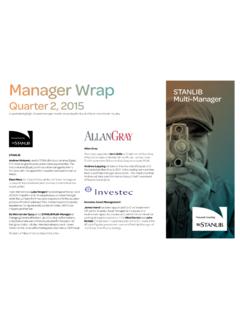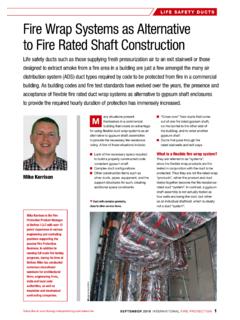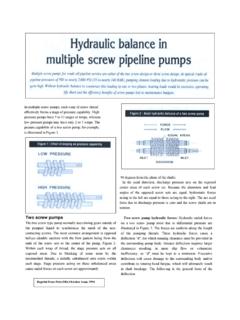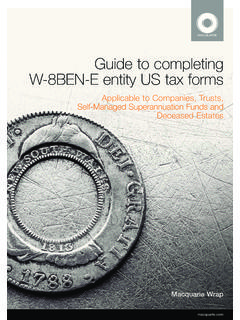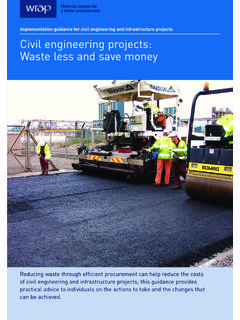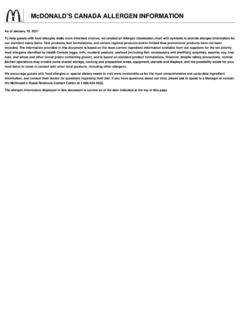Transcription of Example risk assessment: Warehouse
1 Example risk assessment: A Warehouse 3 For each hazard identified, the manager recorded what controls, if any, were in place to manage these. She then compared these controls to the good practice guidance laid out in Warehousing and storage: A guide to health and safety ( ISBN 978 0 7176 6225 8) and Essentials of health and safety at work publications. Where existing controls did not meet good practice, the manager wrote down what further actions were needed to manage the Putting the findings of the risk assessment into practice, the Warehouse manager decided who was responsible for implementing the further actions and when it should be done. She wrote this down and when each action was completed it was ticked off and the date The Warehouse manager discussed the findings with the safety representative.
2 They decided to review and update the assessment at least annually, or at any time when major changes to the workplace occurred. The Warehouse manager gave out copies of the risk assessment to all members of the sceneThe Warehouse manager carried out a risk assessment of the Warehouse . The Warehouse employed 12 staff, some were part of a was the risk assessment done?The manager followed the guidance in Five steps to risk assessment ( ).1 To identify the hazards, the manager :read the Essentials of health and safety at work publication to learn where hazards can occur ( ISBN 978 0 7176 6179 4);walked around the Warehouse , noting activities that might pose a risk and taking into consideration what she learnt from HSE s guidance;talked through the issues with the union safety representative and asked about concerns that staff had on health and safety;talked to supervisors to learn from their detailed knowledge of particular jobs and areas.
3 Andlooked at the accident book to gather information on past The manager then wrote down who could be harmed by the hazards and risk assessment for a Warehouse 1 of 6 pagesHealth and Safety ExecutiveImportant reminderThis Example risk assessment shows the kind of approach a small business can take. Use it as a guide to think through some of the hazards in your business and the steps you need to take to control the risks. Please note that it is not a generic risk assessment that you can just put your company name on and adopt wholesale without any thought. This would not satisfy the law and would not be effective in protecting business is different you need to think through the hazards and controls required in your business for of 6 pagesExample risk assessment: A Warehouse Health and Safety ExecutiveWhat are the hazards?
4 Who might be harmed and how?What are you already doing?What further action is necessary?Action by who?Action by when?DoneFalls from heightStaff could suffer severe or even fatal injuries if they fell whilst climbing staff are given strict instructions never to climb racking monitored by could suffer severe or even fatal injuries if they fell whilst changing light bulbs etc in the high forklift cage used by maintenance worker for changing bulbs. Cage supplier s information shows it is manufactured to maintenance worker to check cage is in good condition and properly secured before each or contractor could suffer severe or fatal injuries falling through fragile roof lights when looking for/repairing controls in place.
5 Put up fragile roof signs, one on each side of the building and at access points to with maintenance worker that a contractor will be used for any access to the contractor to provide an assessment before access is allowed if any roof work is falling from roof of internal Warehouse office used for internal Warehouse roof is load bearing, has full rails and boards around its edge. It has adequate lighting and access is by permanent steps with a further action required. Manual handlingRegular movement of cartons to of stretch-wrap and flat palletsAll Warehouse staff could suffer from back pain if regularly lifting/carrying heavy or awkward system used to reduce manual handling materials in and out of delivery trucks used for most manual handling.
6 A range of manual handling tasks still required. Manual handling training to be given to all Warehouse manual handling tasks to be risk assessed using HSE s Manual handling assessment charts name: GHI Warehouse Date of risk assessment: 10/1/06 Health and Safety ExecutiveWhat are the hazards?Who might be harmed and how?What are you already doing?What further action is necessary?Action by who?Action by when?DoneSlips, trips and fallsAll staff may suffer sprains or fractures if they trip over debris or slip on kept dry and quality maintained. All staff trained to maintain good housekeeping standards and ensure stock does not project into empties bins and removes loose debris daily. Pallets stored safely in designated area.
7 Protective non-slip footwear supplied and worn. Suitable absorber to be made available for liquid to be trained to clean and dry any spillages bins to be provided for waste material near loading objectsFrom racking and during movementA member of staff or any other person in the Warehouse may suffer serious injury if struck by a falling is designed to be suitable for the loads carried and has not been report any damage to racking immediately. System in place to make sure defective pallets withdrawn from use footwear used by all entering Warehouse . Protective gloves provided to handle pallets. Sign fixed to racking stating maximum loads/ of lift trucksInjuries such as fractures or, at worst, fatalities can be caused as a result of:the vehicle crashing into other vehicles and/or other objects;staff and visitors being hit by lift trucks;objects falling from lift trucks onto staff and visitors;lift trucks toppling over; people falling from the vehicle or parts of the vehicle; andbeing crushed by the mast.
8 All operators trained and competent for use of the lift truck. Trucks serviced regularly and examined by suppliers every six instructed to keep keys with them at all times. System in place for refresher training of drivers. Gangways and aisles of sufficient space to enable lift trucks to load and unload from the racking in place to keep vehicles and pedestrians separated. Access to Warehouse restricted to staff. Floor condition maintained on a regular basis, housekeeping standards maintained by cleaner and signs located around the traffic route. Trucks have seat belts and roll cages. Supervisor to ensure truck drivers check trucks each day before pedestrian entrance(s) with protective barrier rail to be provided next to roller-shutter standards and floor condition to be covered by a monthly inspection by manager and brief record requirement that only competent drivers may operate lift trucks to be explained to all staff.
9 Disciplinary action to be taken against anyone involved in breaking this risk assessment: A Warehouse 3 of 6 pagesHealth and Safety ExecutiveWhat are the hazards?Who might be harmed and how?What are you already doing?What further action is necessary?Action by who?Action by when?DoneTraffic movements (deliveries etc)Injuries such as fractures or, at worst, fatalities can be caused by:staff and visitors being hit by vehicle;people falling from a vehicle or parts of a vehicle; andobjects falling from vehicle onto staff and and traffic routes suitable for the vehicles using them. Vehicle routes kept free of obstructions (with spillages being cleaned up promptly).Parking of cars and vans only allowed in marked spaces well away from external delivery/dispatch area gritted when frosty, snow cleared.
10 Sensible speed limits imposed and adhered to. Adequate signage to warn of hazards. Reversing of delivery vehicles should be avoided unless absolutely reversing that is necessary should be overseen by a trained reversing assistant (banksman).Anyone working in the vicinity of moving vehicles should be given training and high-visibility machineAll staff using the machine. Moving parts can trap parts of the body (eg fingers/hand/arm) causing crush injuries. The whole body may also get trapped between moving pallet load and fixed can also cut themselves on sharp edges or scald themselves on hot standard palletised loads wrapped. Machine is relatively new and instructions show it meets the relevant guarding stop button provided.











